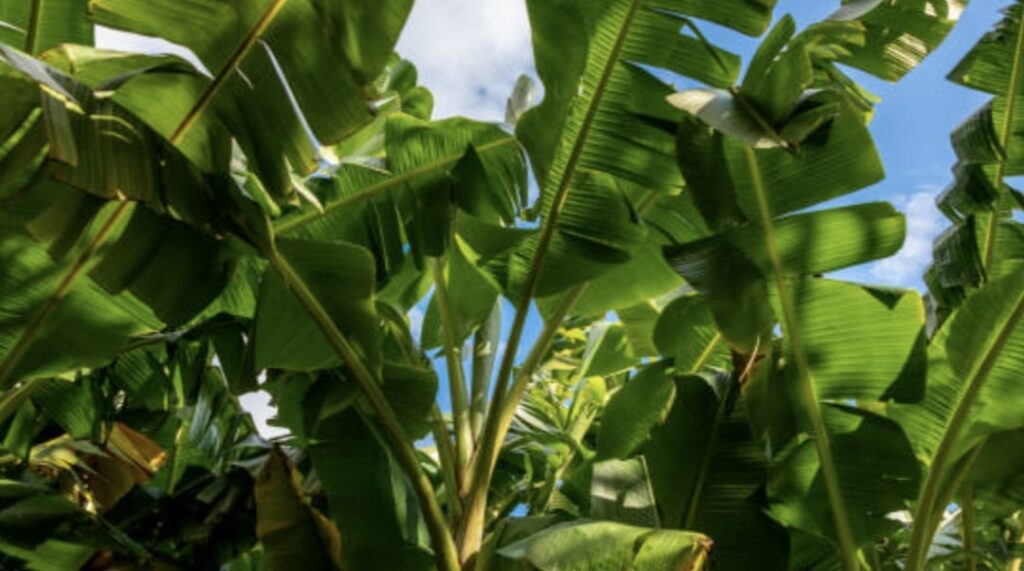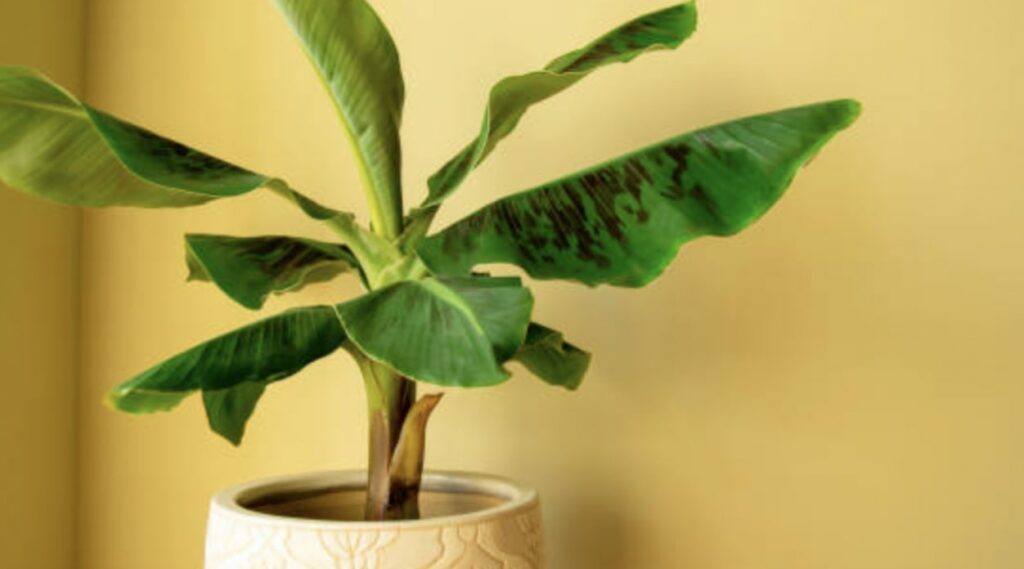Originating from a tropical habitat in Central and South America, banana plants (Musa) need adequate, bright sun daily as well as plenty of water and moisture.
Since the plant requires a lot of moisture, it would be advantageous to plant them in clusters, as this keeps their soil and leaves moist.
On the whole, they’re relatively easy to care for whether you set them indoors or outdoors. That makes them one of the top houseplant choices for plant lovers and gardeners.
So, in this guide, we’ll discuss banana plants entirely, including their description, how to plant and care for them, and more! Without any further ado, let’s begin!
Banana Plant Description


Banana plants are perennial herbs growing from bulbs or rhizomes. That means that they die every winter and regrow the next spring.
They’re prized for their charming style with large, unique ragged leaves that complement most living space decor.
Despite having a plain green color, they are related to the Bird of Paradise and ginger flower. However, you can see a striking resemblance to them with their foliage shape.
Incredibly, there are over 1,000 species of banana plants all over the world. These produce different banana fruit with Cavendish as the most exported banana.
Note, however, that indoor potted banana plants cannot produce fruit indoors. They have better chances of doing so if planted outside.
Banana Plant Size
Unlike other plants, cultivated banana plants grow to an enormous size.
Dwarf varieties can grow to be 10 ft tall, medium banana plants can grow up to 16 ft, and large can reach a mature height of 23 ft. As for their ever-graceful leaves, each can become 8.9 ft long and 2 ft wide.
What should I do before planting a banana tree?


Given their huge leaves, banana trees can be placed and grown in a spacious area inside your house.
It can be displayed in a corner by the window, on your balcony, or in your garden. You can choose to have them on a ceramic pot or a ceramic pot with a low stand.
The Right Potting Mix for Banana Plants
Although banana plants can grow in different kinds of soil, it’s ideal to give them humus-rich, well-draining soil.
Humus-rich soil is soil that’s amended with organic matter.
The best soil mix for banana plants consists of perlite or vermiculite plus organic matter like peat moss, pine bark, coco coir, or aged manure.
Furthermore, check that the soil is slightly acidic, within the pH range of 5.5 to 6.5.
Also, banana plants do prefer moist soil, but it should not be soaked.
So having well-drained soil will allow water to hydrate the roots and the excess to drain out of the soil, thus protecting it from root rot and soggy, damaging soil.
How to Plant a Banana Tree
With knowledge of the soil, sun, and space requirements, you could be ready to plant your banana plant at home. For this, follow the steps below:
- Select a pot
The pot you select is vital to the success of growing a banana plant. A pot that is too small will hinder its ability to grow, whereas one that’s too large will give it excess moisture.
As a rule of thumb, the size of the pot vessel must be double that of the corm or the underground organ of the plant. Also, choose one that has drainage holes so the water can flow out of the soil.
- Fill the vessel with soil
By this time, your soil or soil mix (which we discussed before this section) should be ready. Fill the vessel with roughly 2/3 of this rich, organic soil using a trowel or pouring from a cup or container.
- Set and establish the plant
If you are planting corms, leave a quarter of it exposed under the soil. If the plant has produced leaves, cover the corm and pseudostem (the part of the banana plant looking like a tree trunk) with soil evenly.
- Water
Afterward, finish the planting process by watering the soil. This further establishes the banana plant into the soil.
- Care for it
All that’s left to do is to care for the plant by watering it regularly, feeding it with fertilizer, and pruning it. We’ll discuss more of them in a bit.
Banana Plant Requirements


Let’s now zero in the requirements of the banana plant with regard to sun, temperature, and humidity needs.
Sunlight
The sunlight needs of a banana plant depend on its variety. Most banana plants thrive in full sun every day, but some with variegated leaves prefer shaded sun, as their leaves can suffer burns.
They need about 4 to 6 hours of bright light daily. So you can place them near a south-facing window of your house.
What’s more, you may wish to transfer them outdoors during moderately hot summers. They love these conditions.
Conversely, in the winter, they need less direct light, but make sure you acclimate them to this condition little by little first.
Temperature and Humidity
Banana plants love a warm and humid climate like their native location. Place them in a spot in your house between 68℉ and 85℉.
In addition, the perfect moisture level for them is around 50%. In winter, these plants can dry up faster, but spritzing them with water and/or switching on the humidifier should help them stay moist.
Caring for Banana Plants at Your House
Here’s an outline of what you have to do to care for your banana plant at your house:
Watering
It’s a little different to water banana plants as opposed to other kinds of plants.
Aim to water your indoor potted banana plant with small amounts of water every day. If you keep them outside, you should water them deeply every two to three days.
When, somehow, you’ve forgotten your watering schedule, check the soil. If the top 0.5 in of the soil is dry, that’s a sure sign your banana plant will benefit from watering soon.
Also, since banana plants lose a lot of water through their large foliage, you have to water them more often during the summer than in the winter.
Fertilizing
Feeding your banana plant often is vital to its lush and healthy growth. They’re fast growers, so they would greatly benefit from the extra nutrients you give them.
The best fertilizer to give them is one that has an NPK (nitrogen, phosphorus, and potassium) ratio of 5:3:3, promoting their leaf growth.
Besides healthy leaf growth, fertilizing may also encourage flower production. Yes, banana plants, especially those grown outdoors, can also produce a single maroon flower or a cluster of such!
About when and how often you should feed the plant, it should be every two weeks during its summer growing season and once a month during its dormant season from fall to spring.
Pruning
Pruning isn’t generally needed for your banana plant, but some plant owners choose to in order to keep it growing neat and energetic.
Compared to most plants, pruning is done differently for banana plants. Rather than trim the plant when the leaves fade and fall, it’s done as the plant is growing.
Naturally, banana plants grow from a corm, which in turn, produces a few pseudostems that unusually look like a tree’s trunk. All will be removed except the one that looks the healthiest.
Now the emerging shoots from the pseudostem have to be cut using sharp garden shears.
Along with that, you can remove tiny suckers coming out of the corm, which will allow the plant to focus its energies on growing its main stalk and leaves.
Repotting
Repotting a banana plant needs to be done approximately every three years. That’s because it’s a fast and big grower.
If you don’t repot the plant, it will most likely cramp and stop growing until you do something about it.
Anyway, it’s easy to repot a banana plant. Here’s an outline of the simple steps that are needed for it:
- Lay the old potted plant on the side.
- Carefully pull the plant out along with its roots.
- Transfer it into its new pot container, which should be 4 in to 6 in larger in diameter than the previous one.
- Brush off the old soil off the corm and roots.
- Fill in the pot with 2/3 of the banana plant soil mix.
- Water the plant to establish it.
Propagating
Propagation is the process of breeding a plant from its parent stock. You will therefore get a plant with the same characteristics and style.
You can then expand your banana plant quantity in the garden or give the new plant to a close friend or family member.
Here’s how you can propagate your banana plant:
- Get a multi-stemmed plant
Pick a banana plant that has multiple pseudostems that produce suckers at least a foot tall. If you choose one with only one stem, the parent stock will die, so let it grow for a while.
- Remove the sucker, corm, and root
Then, you need to remove a portion of the corm, roots, and the small sucker. Be sure that you take no more than 25% of the corm.
- Take out the leaves
Take out the large leaves that came with the portion you removed. You can choose to leave a few small ones if you want to let them grow on their own.
- Place it in the new pot
Finally, you can plant the corm in the new pot you have. The top round part of the container should be wider than its base to accommodate the large overhanging leaves.
And same as when repotting, water it to establish the banana plant in its new home.
Banana Plant Pests and Diseases
If not cared for properly, a banana plant can be prone to certain pests and diseases.
Common harmful pests include nematodes, thrips, weevils, scarring beetles, and sap-sucking insects like mealy bugs, spider mites, and aphids.
To thwart their efforts, you can use safe and natural solutions such as soapy water, insecticide, or horticultural oil. Or you can plant certain flowers and plants to attract ladybugs, which will, in turn, eat up these critters.
As for the diseases, most of them are fungal. Some examples are Sigatoka, which causes leaf streaks or spots; the lethal Banana Wilt, which travels from the soil to the pseudostem and makes the leaves yellow; and Black End, which infects and rots the entire plant.
So long as you care for the plant properly by following our advice and tips above, your banana plant should be completely free from these unwanted pests and sicknesses.
FAQs about Banana Plants
- Do banana plants love coffee grounds?
Banana plants love coffee grounds since they contain decent amounts of nitrogen, phosphorus, copper, and magnesium to benefit them.
Another reason is that coffee grounds are neutral on the pH scale so that means they won’t raise or lower the acidity level of the soil.
Third, you can very easily incorporate them into your soil mix or organic compost, depending on your choice.
- How do I take care of a banana plant during winter?
From late fall to winter, the banana plant can naturally become inactive.
To protect it, you must place the plant in a pot filled with damp sand and transfer it indoors in an area at a cool temperature (15℉ or above) to help it adapt to the weather.
When it becomes dormant, it will need less watering and fertilizing. Only water it when the top 0.5 in of soil is dry, and fertilize it only once a month.
Moreover, look out for bugs or pests that can prey on the plant. Spray them out with soap and water solution or a gentle insecticide.
- Why are the leaves on my banana plant curling?
You may notice that your banana plant leaves curl at one point. This is due to the weather being too hot.
This is just a normal response of the leaf to prevent excess moisture loss or evaporation from it. In this case, you can spray some water to give those leaves some relief.
Plus, examine the soil if it’s dry. If it is, it’s time to water the plant again enough to make the soil moist.
- Why are the banana plant leaves turning yellow?
When the leaves of your banana plant are turning yellow, it can indicate that it’s not getting the nutrient it needs or that it is suffering from a pest or fungal disease.
So, when that happens, check that you’re not overwatering or overfeeding the plant with fertilizer. If you are, correct it immediately by repotting the plant or just refraining from doing so the next time.
More Plant Care Guides:
You may also be interested in the plant care articles listed below:



